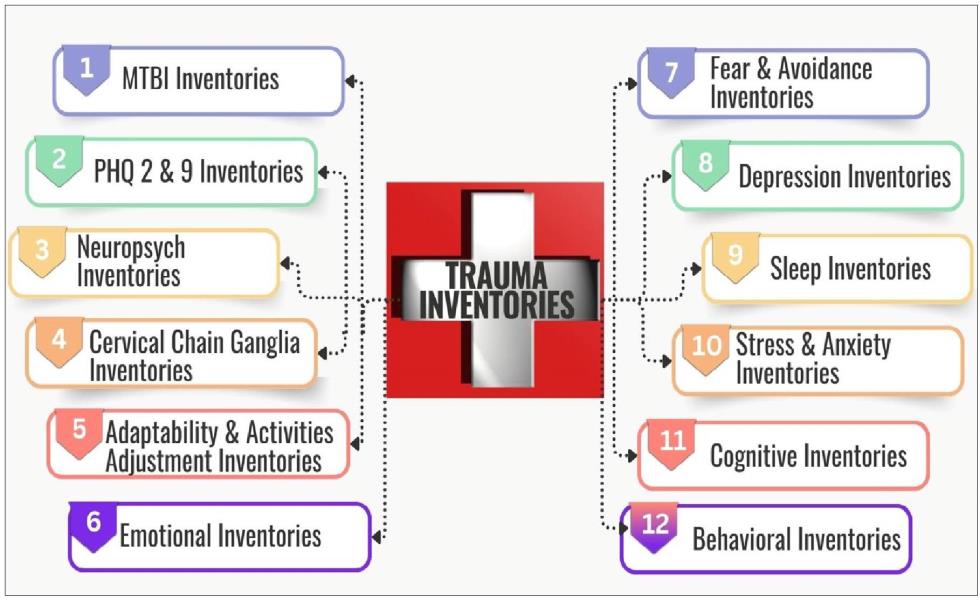How Chiropractors Can Become Indispensable in PI Cases
March 1 2025 Frank LibertiHow Chiropractors Can Become Indispensable in PI Cases
March 1 2025 Frank Liberti
IN THE REALM OF PERSONAL INJURY CLAIMS, chiropractors are often at the forefront of evaluating and documenting patient injuries. However, traditional assessments, such as activities of daily living (ADL), loss of enjoyment (LOE), and duties under duress (DUD), frequently fail to capture a critical dimension of injury impact — the emotional, cognitive, noneconomic, and socioeconomic consequences of trauma. This is where trauma inventories emerge as a valuable yet underutilized resource, offering a more comprehensive understanding of the true toll injuries take on patients’ lives.
Trauma inventories are structured assessments, typically in the form of standardized surveys and questionnaires, designed to capture dimensions of injury impact that are often overlooked in traditional medical evaluations. While physical impairments are routinely documented, trauma inventories delve into emotional distress, cognitive impairments, behavioral changes, and socioeconomic disruptions.
These inventories are adaptable to modern healthcare workflows, ensuring flexibility for both providers and patients. They can be administered electronically, via telemedicine consultations, or through in-person evaluations.
For chiropractors, integrating trauma inventories offers a structured approach to identifying and documenting the hidden consequences of trauma, ultimately improving the accuracy of injury assessments and supporting a more holistic patient assessment model.
Trauma Inventories typically assess the following key areas:
1. Mild traumatic brain injuries (MTBI)
2. Family health and adaptability
3. Neuropsychological symptoms
4. Chain ganglia injuries
5. Adaptability and activities adjustment disorders
6. Emotional distress
7. Fear and anxiety
8. Depression disorders
9. Sleep and stress-related impacts
10. Stress and anxiety
11. Cognitive health
12. Behavioral health
Each category reveals insights into how injuries affect the physical body and emotional well-being, mental health, and daily functionality. These nuanced findings allow chiropractors to contribute meaningful data to injury claims and provide a more accurate picture of the overall injury impact.

For chiropractors, the significance of trauma inventories lies in their ability to quantify and validate often-ignored injury consequences. While traditional medical evaluations address physical symptoms, they frequently miss the noneconomic damage factors, such as anxiety, loss of sleep, inability to focus, and diminished quality of life.
For attorneys, trauma inventories offer a foundation of credible, reproducible data that strengthens injury claims and facilitates fairer settlements.
For patients, they represent validation. Their struggles are documented, acknowledged, and addressed in ways traditional assessments often fail to achieve.
Chiropractors who add trauma inventories to their evaluations enhance patient relationships and care while elevating their role as trusted professionals in the injury claims process.
The Role of Technology in Trauma Assessments
Modern technology has made the integration of trauma inventories into chiropractic workflows both practical and efficient. Digital platforms enable:
• Secure data collection: Through encrypted online surveys and telemedicine assessments.
• Streamlined analysis: Automating data evaluation to reduce administrative burden.
• Increased accuracy: Minimizing human error and improving reproducibility.
This level of technological integration ensures that trauma assessments are conducted with consistency, reliability, and scalability, which are essential factors to support injury claim documentation.
Take the case of Mary, a patient who had been struggling with the aftermath of a car accident. Her initial medical evaluations primarily addressed physical injuries, overlooking her emotional and cognitive challenges.
When a trauma inventory assessment was conducted, it revealed significant emotional distress, persistent anxiety, and sleep disruptions. These findings became a pivotal element in her injury claim, offering a more complete representation of her reality after the accident.
For Mary, the assessment improved the outcome of her claim and provided her with validation and peace of mind, knowing that her struggles were accurately represented in her case documentation.
Chiropractors who incorporate trauma inventories into their evaluations distinguish themselves in a competitive field. This approach:
• Strengthens professional relationships: Attorneys value providers who deliver thorough, evidence-based documentation.
• Improves patient outcomes: Holistic assessments ensure more comprehensive care plans and capture overlooked noneconomic damages valuation.
• Elevates professional credibility: Data-driven insights position chiropractors as indispensable allies in the injury claims process.
“Modern technology has made the integration of trauma inventories into chiropractic workflows both practical and efficient.”
This is not merely an administrative upgrade but an evolution in how chiropractors contribute to injury claim outcomes and patient advocacy.
The integration of trauma inventories represents a paradigm shift in personal injury chiropractic care. By capturing a full spectrum of injury impacts, chiropractors can play a more central role in advocating for their patients and supporting fair claim valuations.
For those considering adopting trauma inventory protocols, the benefits extend beyond better claim outcomes, including stronger attorney partnerships, enhanced professional credibility, and a reputation for delivering exceptional patient care and concern.
Exploring how these tools align with your practice’s goals could mark a pivotal step toward improving patient advocacy and professional outcomes in the evolving landscape of personal injury care.

Dr. Frank Liberti has a career spanning 35 years. His advice on personal injury has been published extensively and his work has appeared in broadcasts of NBC, CNN as well as Entrepreneur Magazine. He has consulted over 35,000 doctors and lawyers on the subject of personal injury and is a keynote speaker on personal injury across the United States. Early in his career he set precedent at the New Jersey State Supreme Court on the subject of personal injury and has authored five books on personal injury mandates of litigation.
For more information visit www.PI-AID.infc or contact Dr. Frank Liberti [email protected].
 View Full Issue
View Full Issue









